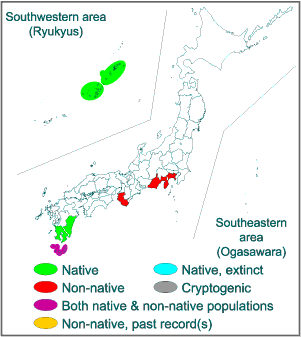- Ota et al. (1995) Colonizations of two exotic reptiles of Hachijojima Island of the Izu group, Japan. Biol Mag Okinawa 33:55-59.
- Maenosono & Toda (2007) Distribution of amphibians and terrestrial reptiles in the Ryukyu Archipelago: A review of published records. Akamata. 18, 28-46 (in Jpn)
- Matsuo (2004) Amphibians and Reptiles of Nagasaki Prefecture, Japan. Nagasaki Shinbunsha (in Jpn)
- Sengoku et al. (eds) (1996) The Encyclopedia of Animals in Japan 5 Amphibians, Reptiles, Chondrichthyes. Heibonsha, Tokyo (in Jpn)
- Toda & Hikida (2011) Possible incursions of Gekko hokouensis (Reptilia: Squamata) into non-native area: an example from Yakushima Island of the Northern Ryukyus, Japan. Cur Herpetol. 30(1), 33-39.
- Toda & Yoshida (2005) Issues and perspectives regarding invasive alien species of amphibians and reptiles in Japan. Bull Herpetol Soc Jpn. 2005(2), 139-149 (in Jpn)
- etc.
|
|

 Japanese |
English
Japanese |
English